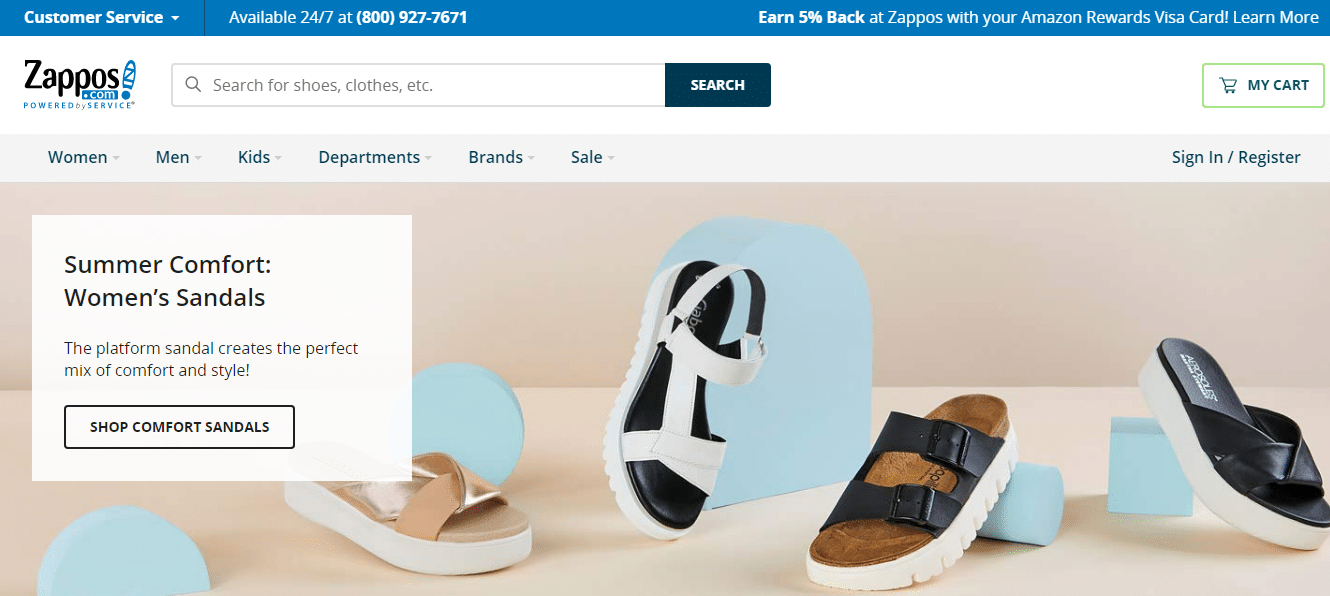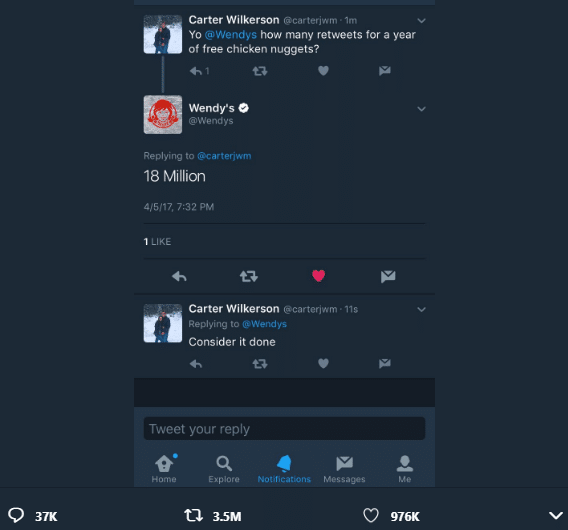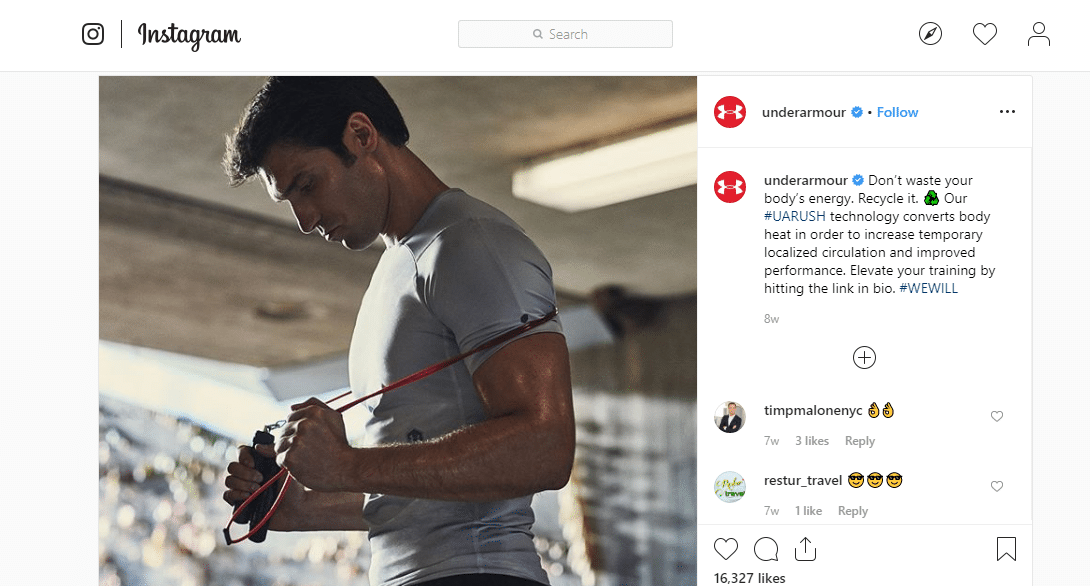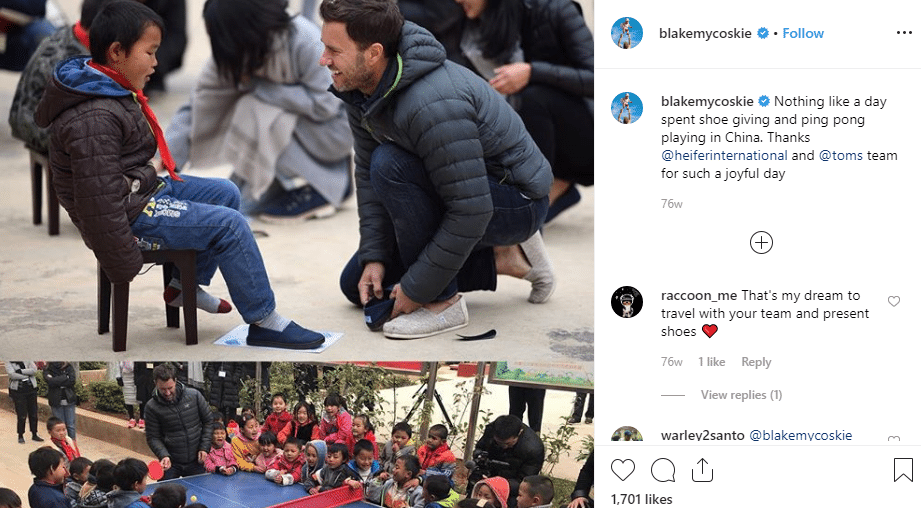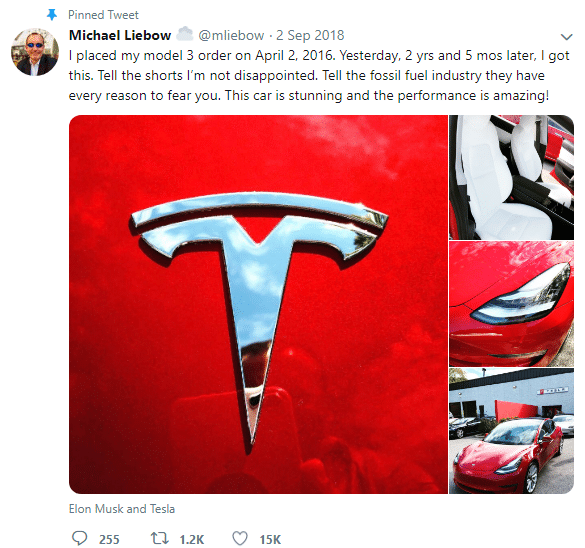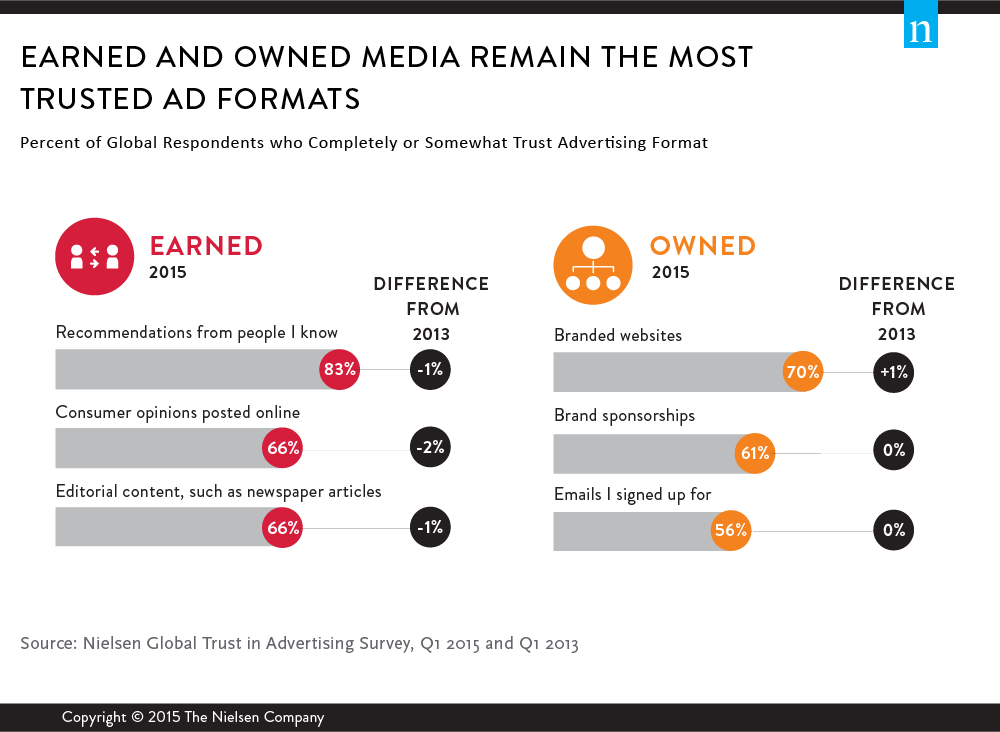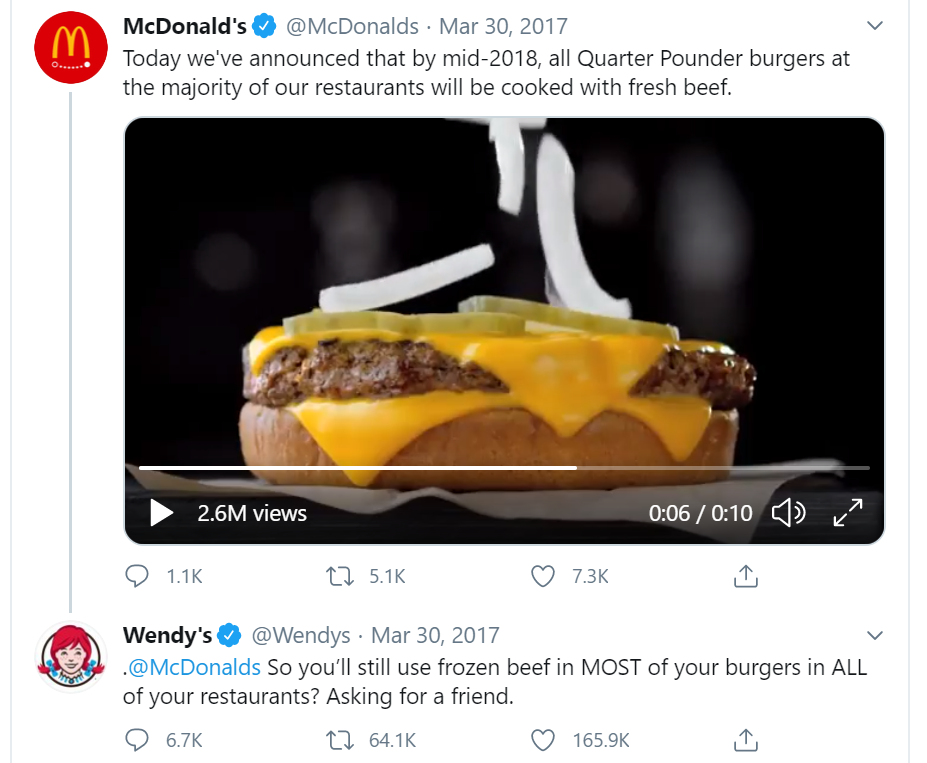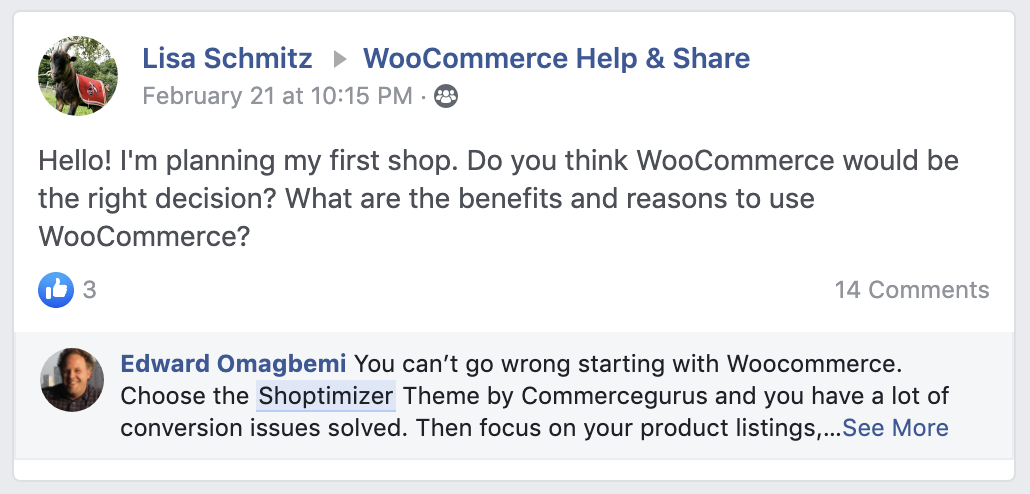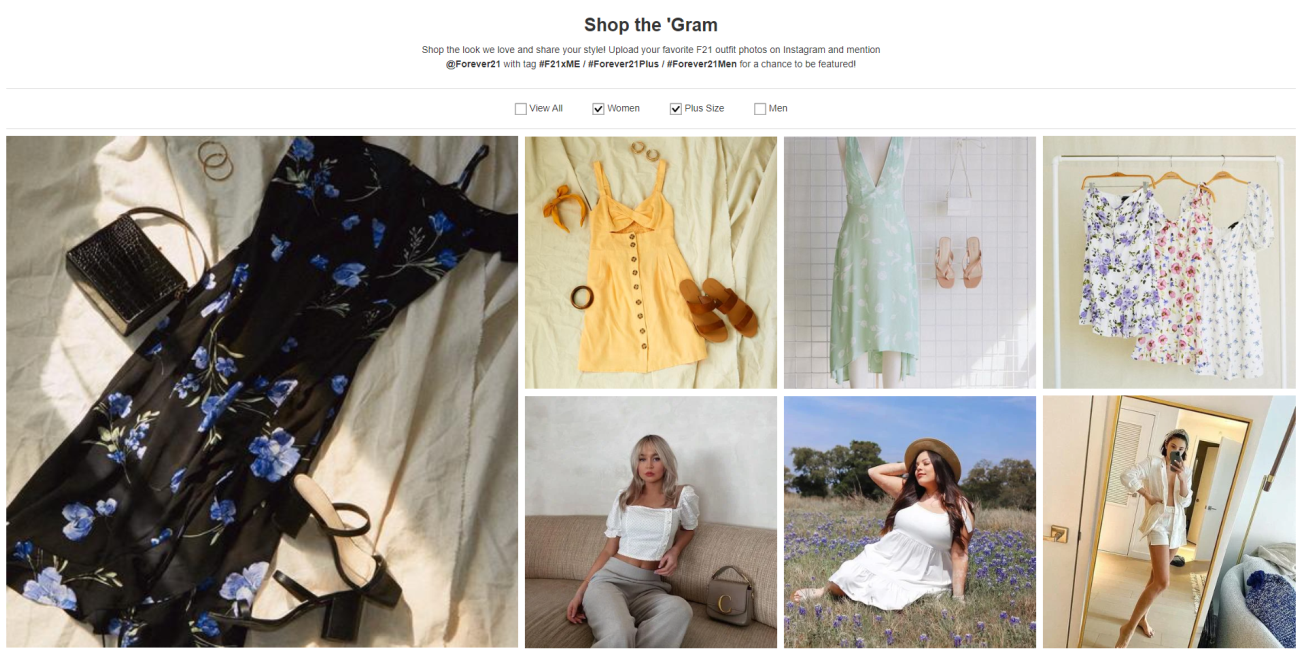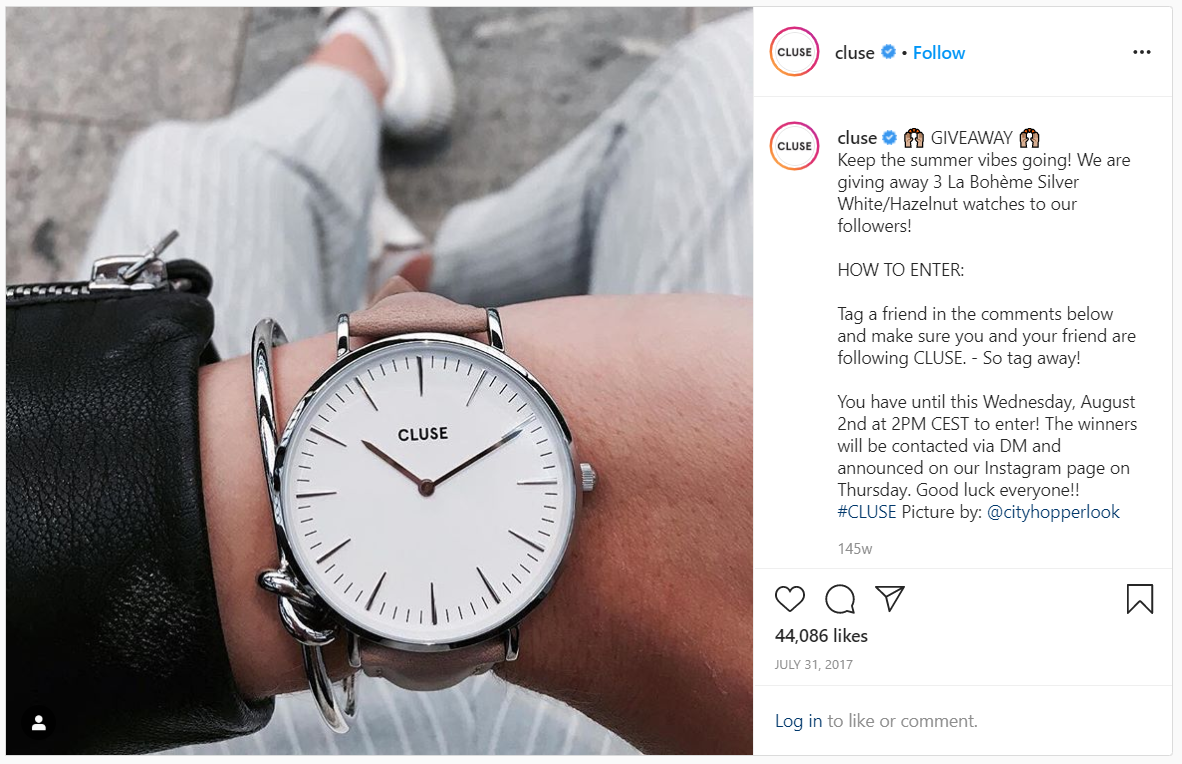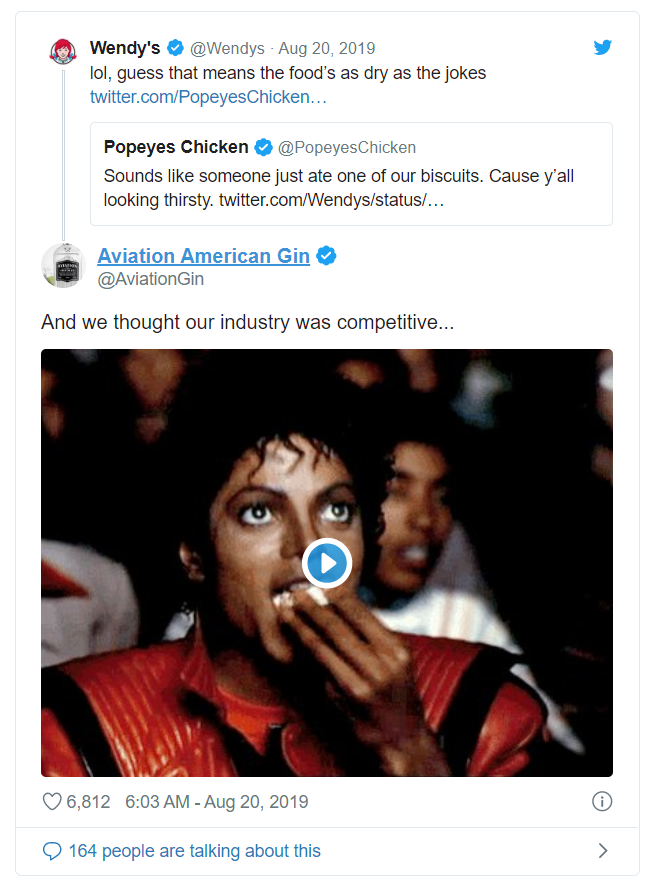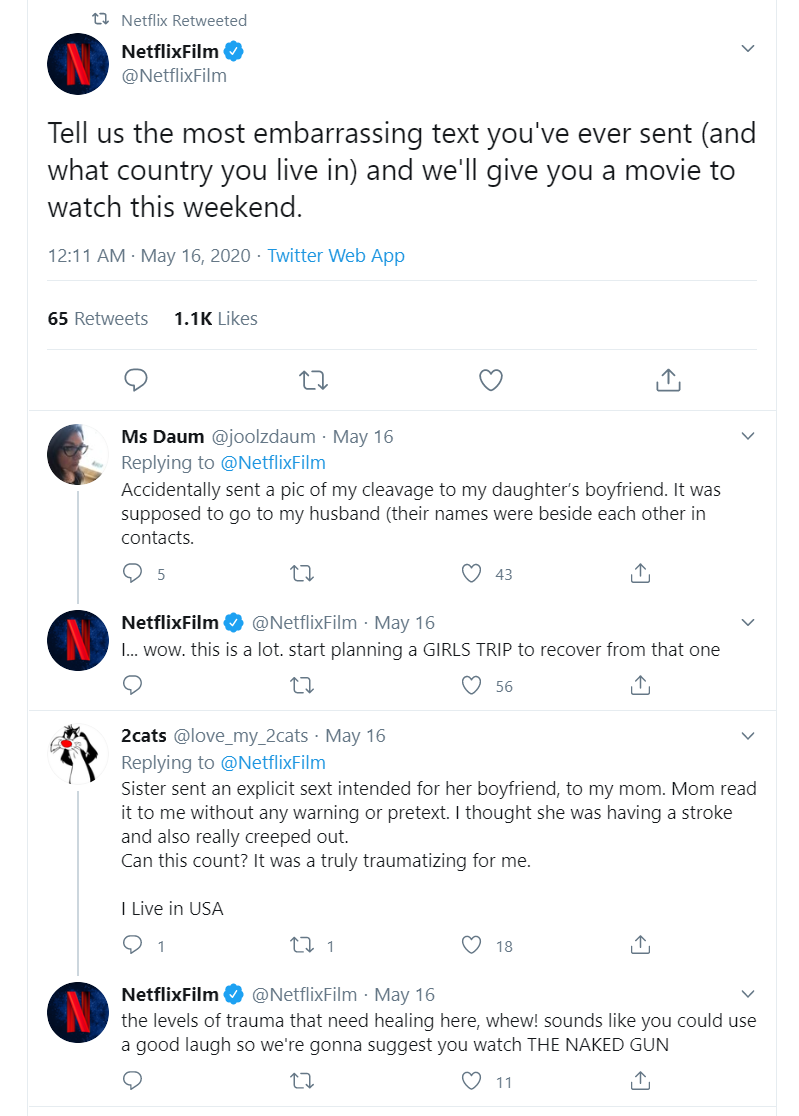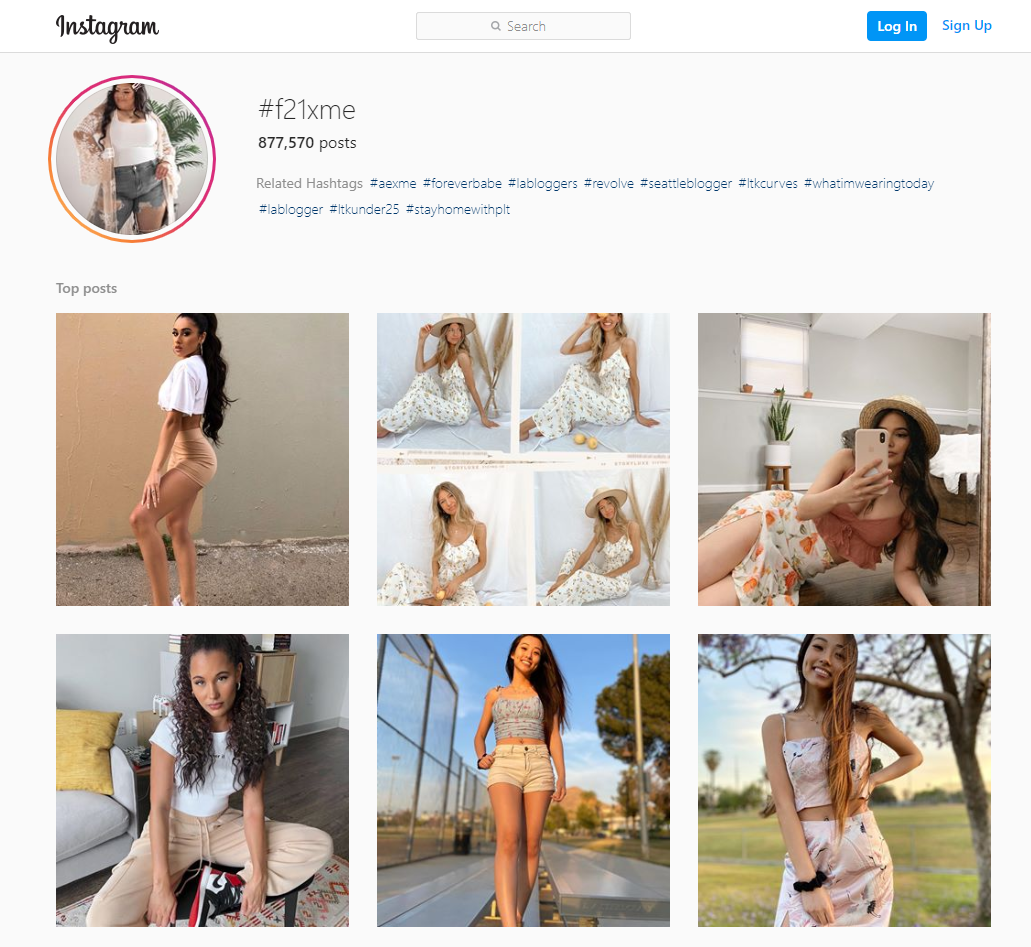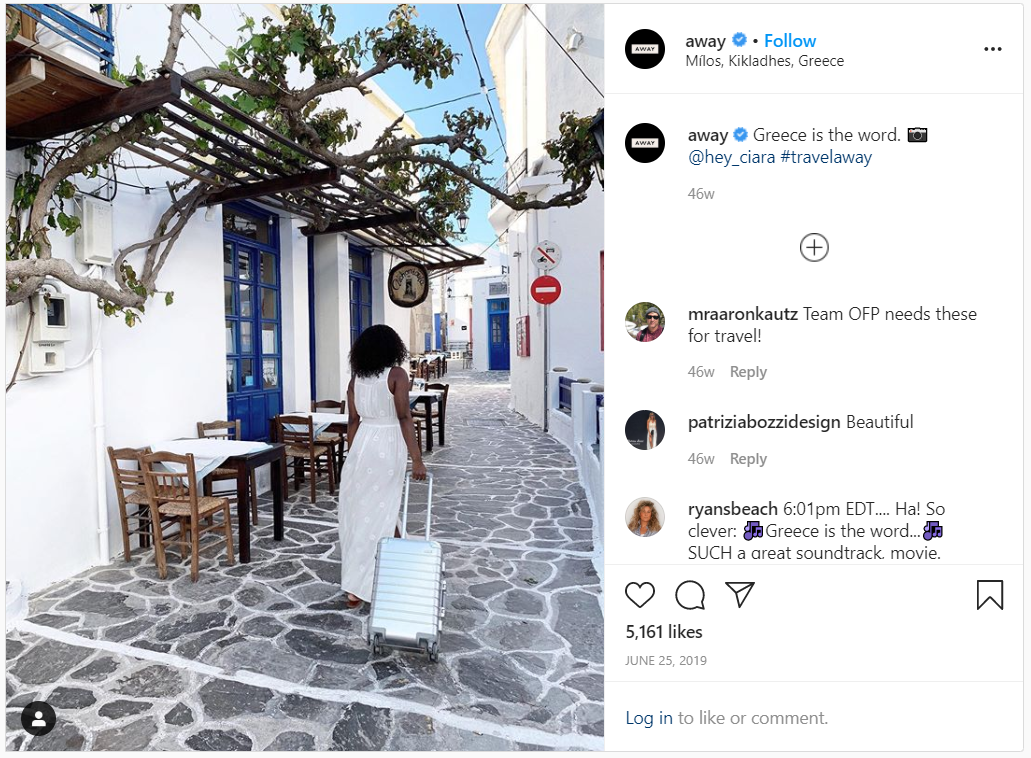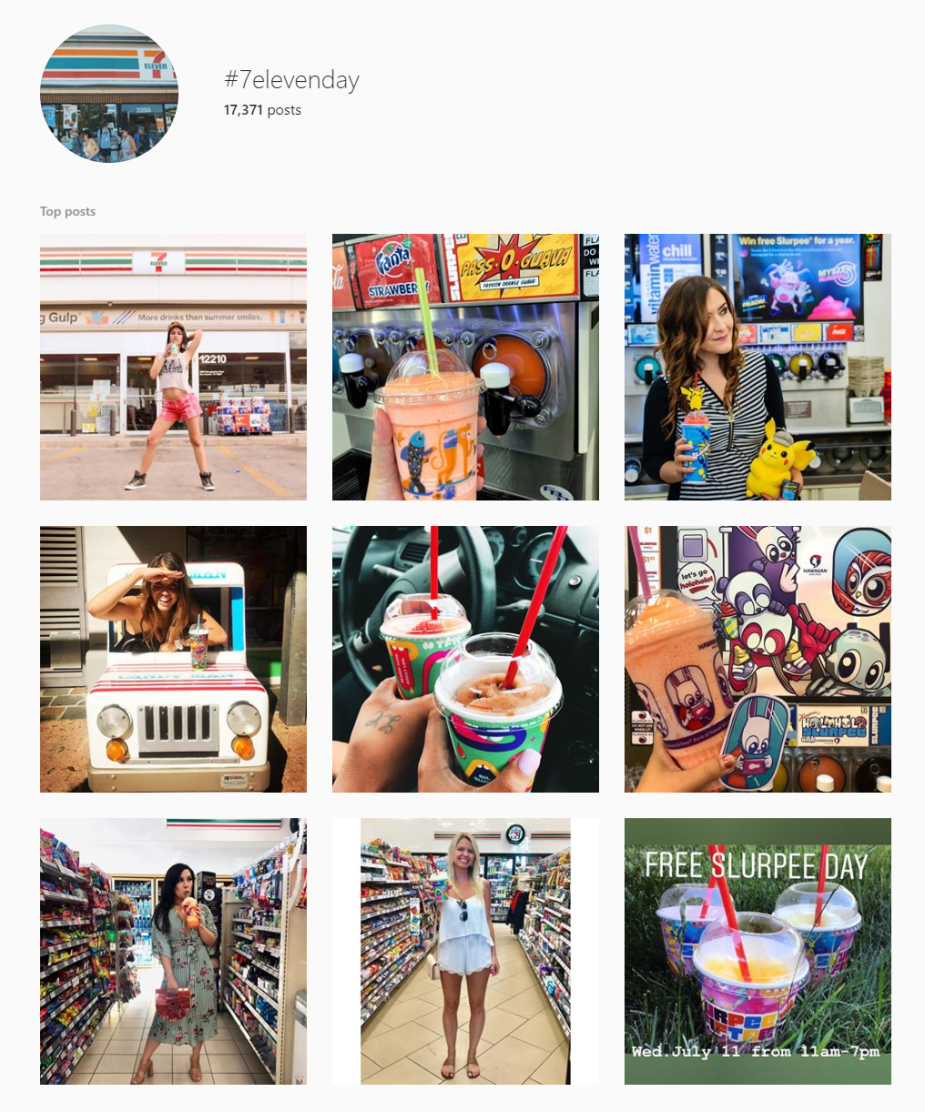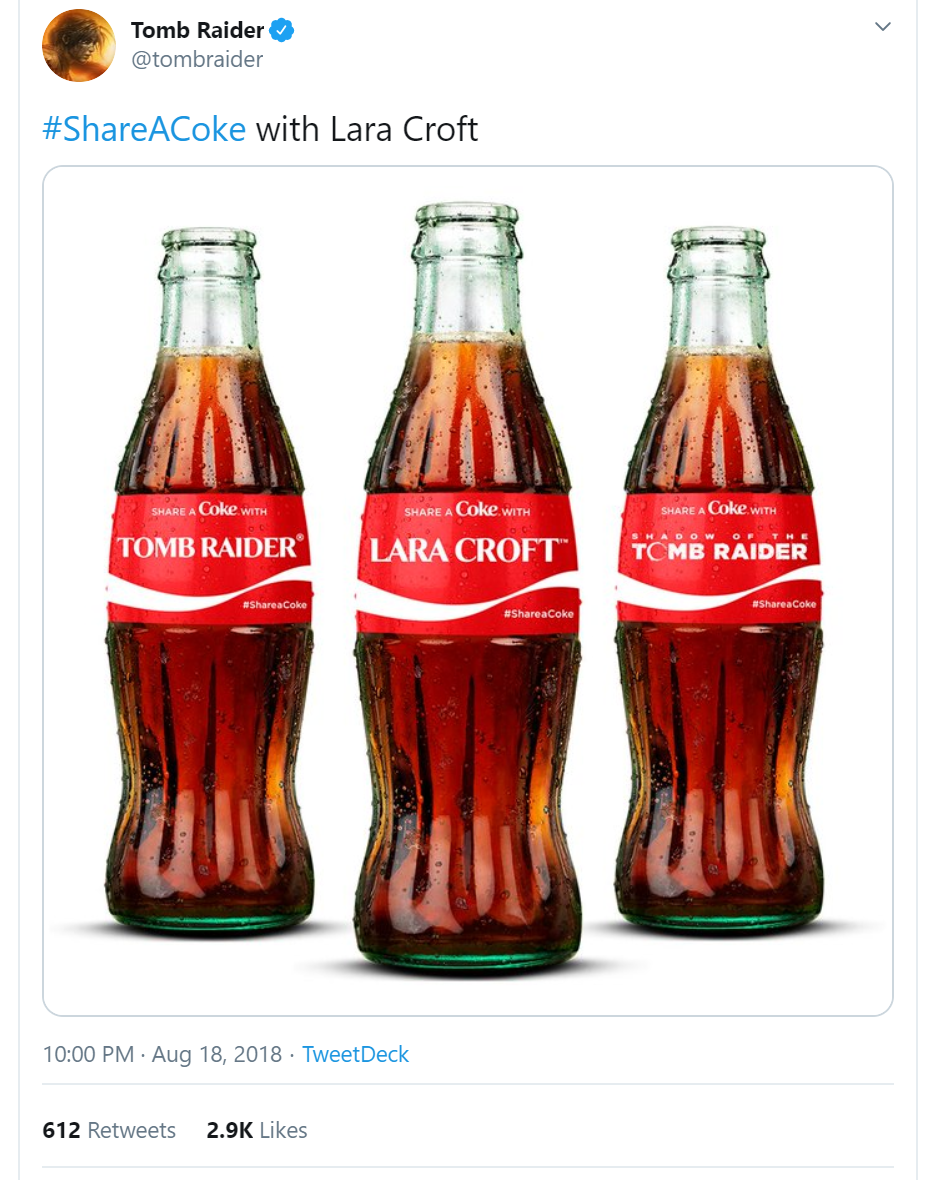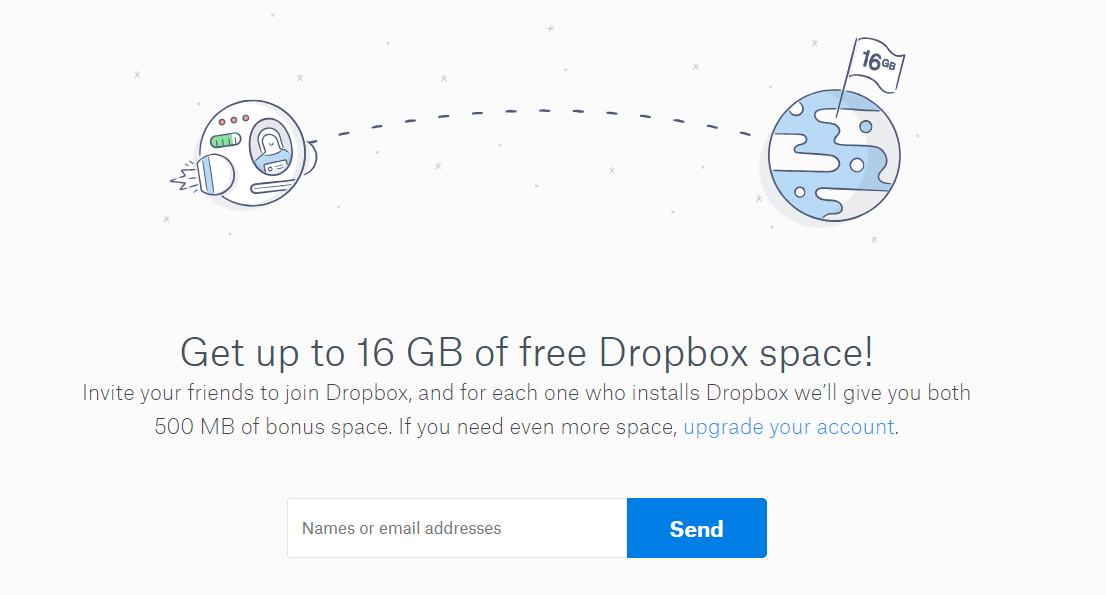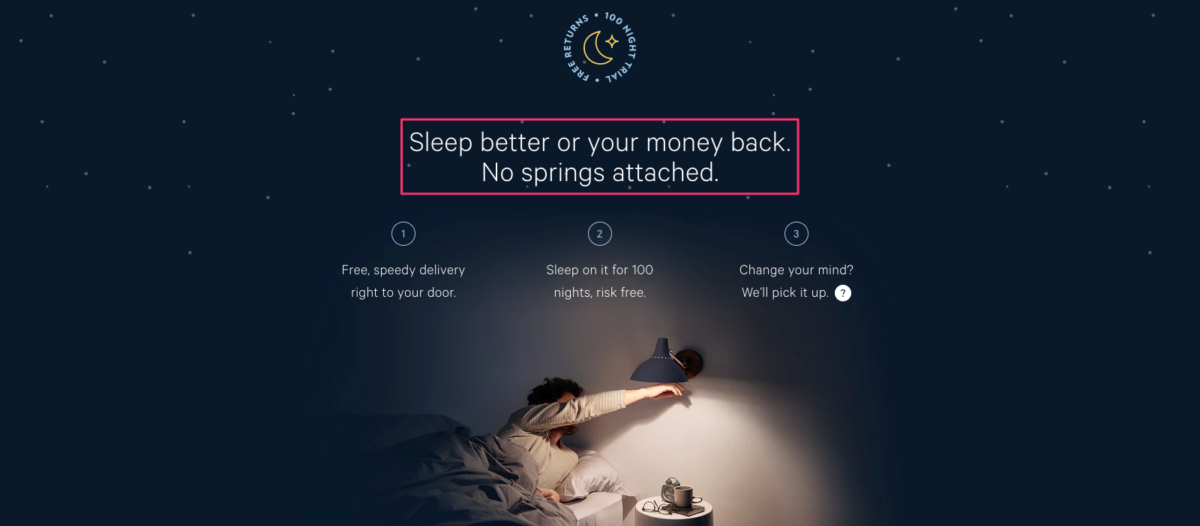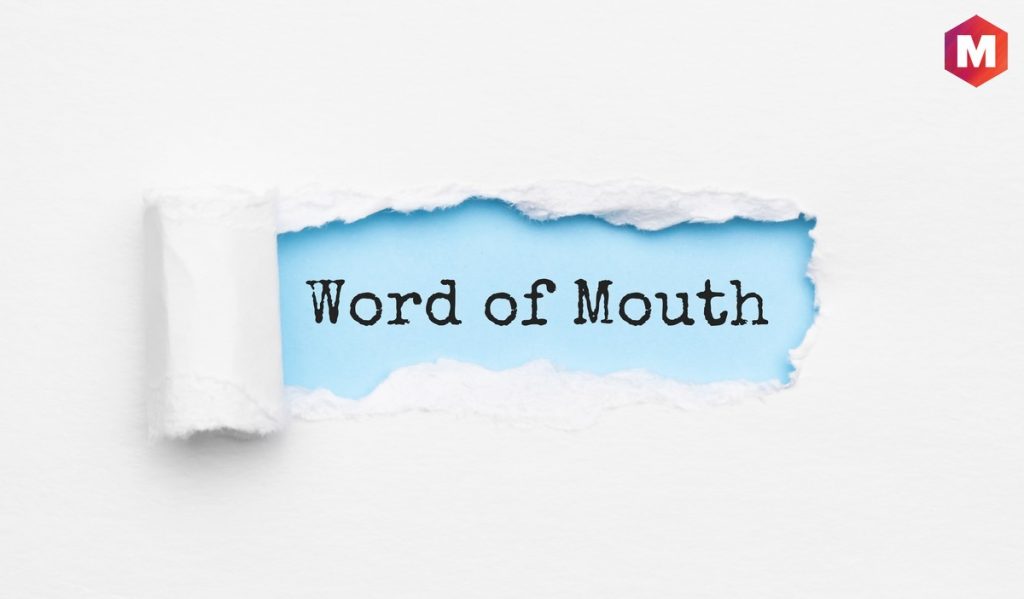A majority 92% of consumers trust recommendations from their friends, family, and peers more than any other form of marketing. And 83% of Americans say that word of mouth recommendations from people they trust to make them more likely to purchase a product or service.
So, if you’re trying to figure out the best way to acquire new customers, promoting word-of-mouth marketing from your existing customers is a smart decision. Simply put, word-of-mouth occurs when your customers spread the word about your brand to their friends—and this promotes your brand at no cost to you.
But word-of-mouth can be unpredictable. So how can you get your customers talking? Check out how these 11 brands have successfully used word-of-mouth, including the major strategies they’ve used to get everyone talking, so you can gather some ideas for your own business.
Zappos
Word-of-mouth strategy: Keeping customers satisfied
Keeping your customers satisfied encourages them to share your brand with friends, a strategy Zappos knows well. Rather than focusing primarily on paid advertising, Zappos makes customer satisfaction a priority— as CEO Tony Hsieh puts it, they’re “a customer service company that just happens to sell shoes.”
From the beginning, Zappos has spent a large amount of its marketing budget on fostering extraordinary customer service, and very little on ads. According to Hsieh, Zappos decided to “take most of the money that [they] would have spent on paid advertising…and instead invest it into the customer experience, and let [their] customers do the marketing for [them].”
(Some ways that Zappos prioritizes customer satisfaction include surprise, complimentary shipping upgrades for loyal customers, and making the return and exchange process as easy as possible.)
Thus, under the leadership of Hsieh, Zappos smartly put their money on word-of-mouth marketing, figuring that satisfied customers would both repeatedly buy and share Zappos with their friends. And they were right. Repeat customers and word-of-mouth marketing have been the top drivers of growth for Zappos, which today exceeds $2 billion in annual revenue.
Wendy’s
Word-of-mouth strategy: Leveraging social media; creating virality
Social media is an awesome way to increase word-of-mouth, especially if your brand’s savvy, witty posts, and interactions stand out from the pack—and even go viral. Wendy’s offers a prime example.
Thanks to its roasts, on-point memes and timely pop culture references, Wendy’s now-iconic Twitter account got everyone talking about the fast-food brand. And their response to Carter Wilkerson’s “free chicken nuggets” tweet ignited a hyper-viral word-of-mouth campaign.
Wendy’s told Wilkerson that 18 million retweets of his tweet would earn him free chicken nuggets for a year. Wilkerson didn’t reach that goal, but at the time, his tweet set a record for the most retweets of all time! So, Wendy’s response got everyone talking (including countless media outlets, who gave the chain plenty of free coverage.)
The viral Twitter exchange between Wendy’s and Wilkerson. Notice the retweet count at the bottom of the image.
Under Armour
Word-of-mouth strategy: Creating an innovative product with little to no competition
Instead of throwing itself into a crowded athletic wear market, Under Armour sparked word-of-mouth marketing by setting itself squarely apart from its potential competition. Under Armour created athletic apparel focused on athletes’ performance and comfort, “built from microfibers that wicked moisture and kept athletes cool, dry, and light.”
Under Armour always focuses on the performance features of their apparel. Source
Founder Kevin Plank had played football throughout high school and college. He knew how rough it was to wear cotton shirts under his football gear, where they would become heavy and uncomfortable with all the sweat they were drenched in. So, he created a product and niche that no one else had dreamed up before.
Then, he gave the first samples to his friends who also played football (and who had gone on to play for prestigious college and professional teams). He soon competitively positioned himself to sell to collegiate and professional football teams because his friends on those high-level teams were spreading the word about his product.
Before long, athletes of all levels and sports (including many pros), their families, and their friends were constantly talking about Under Armour—now an athletic apparel giant all its own.
Red Bull
Word-of-mouth strategies: Buzzworthy, on-brand experiences; brand ambassadors
Red Bull uses a multi-pronged strategy for increasing word-of-mouth, but all parts of this strategy are focused on creating on-brand adventures and experiences that generate buzz.
From the beginning, their Wings Team of young, adventurous brand ambassadors, who share Red Bull one-one-one and at events, have been an integral part of their marketing strategy.
The brand also sponsors crazy extreme stunts that people can’t stop talking about, like cliff diving and Robbie Maddison’s motorcycle backflip over London’s open Tower Bridge, and hold an annual Flugtag where competitors design and pilot human-powered flying machines.
Red Bull knows how to “give wings” to their marketing through experiences that get people talking.
The motorcycle backflip stunt
TOMS
Word-of-mouth strategy: Focus on philanthropy/giving back
Word-of-mouth has been integral to the success of TOMS since the beginning, driven by its philanthropic “one for one” model.
On a trip to Argentina, founder Blake Mycoskie saw the difficulties children without shoes faced and decided to start TOMS as the vehicle for a shoe-giving movement. For every pair of TOMS purchased, the brand gives a pair to children who cannot afford shoes.
This charitable angle—and founding story— made it easy for word to spread about TOMS.
TOMS founder Blake Mycoskie on a shoe-giving trip to Hong Kong. Source
Digital marketing consultant MaryEllen Tribby shared a prime example of this phenomenon: her 13-year-old daughter convinced her to buy three pairs of TOMS by sharing the company’s shoe-giving mission. Says Tribby, “Even though I thought three pairs of shoes at $77-a-pop was a bit extravagant; I justified the decision in my head, telling myself that I would be helping kids who weren’t nearly as fortunate as my own.”
TOMS also takes advantage of social media to increase cause awareness and word-of-mouth. The brand created the One Day Without Shoes campaign and pledged to donate another pair of shoes for every barefoot picture posted with the hashtag #withoutshoes on the day. Plus, every picture someone posts with the hashtag motivates a social media user’s network to learn more, and follow the trail back to TOMS. TOMS reignites the campaign every year because it’s been so successful!
Chipotle
Word-of-mouth strategies: Telling a story based on a cornerstone and backing it up; delivering what customers want
Chipotle stands out from other restaurant chains because it sources its ingredients locally. The brand used this cornerstone to create an emotionally compelling video, “The Scarecrow,” to promote word-of-mouth about its sourcing.
Through the story of a scarecrow that becomes skeptical of a dominating food factory, “The Scarecrow” painted a picture of environmental, health, and animal welfare threats created by industrial food giants, and promoted buying locally sourced food as a way to “cultivate a better world.”
Interestingly, the video only featured the Chipotle logo at the very end, so the content felt much less like a paid ad. Instead, the focus stayed on the video’s story and carefully crafted art.
Chipotle also created a “Scarecrow” app with the same animation quality and moving story as the video. This viral content motivated customers to keep watching, playing, and sharing with their friends.
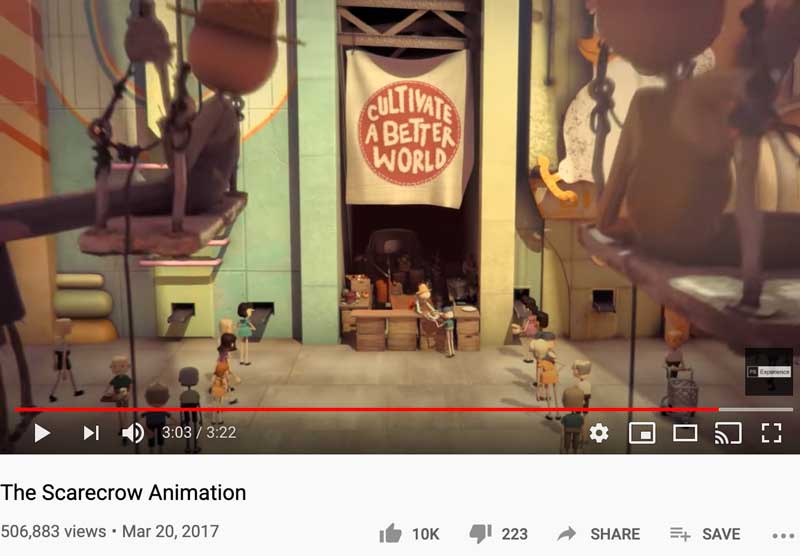
More recently, Chipotle has suffered from food safety scandals and the negative press that has accompanied them, but they have responded quickly to turn things around (including by closing all locations for company-wide food safety training).
They are striving to restore their previous reputation by delivering what customers want, such as “nachos,” “quesadillas,” and a “loyalty program.” Plus, they’ve increased their amount of organic ingredients, upped their veggie offerings, and added keto- and Whole 30-compatible menu items, to drive home their natural commitment.
Chipotle realizes that increasing positive word-of-mouth is all about telling a standout story and backing it up in everything they do. And this has worked: Chipotle’s stock shares rose 55% in 2019, on top of a 57% gain in 2018.
Tinder
Word-Of-Mouth Strategy: Offering value to their audience
You probably don’t think about word-of-mouth when you think of online dating giant Tinder, but word-of-mouth was integral to Tinder’s rise. After winning a 2012 hackathon with the original version of the app, co-founders Sean Rad, Justin Mateen, and Joe Munoz needed a way to publicize the app.
They decided to promote it at a USC party that Mateen’s younger brother was holding, via word-of-mouth: students who wanted to get into the party had to download the app. Even though many of the students didn’t know what the app was, they soon started matching and swiping when they got back to their dorms. Tinder offered value to them because they knew the people the app was showing them were already interested in them (so, they didn’t have to worry about rejection).
Source
Rad, Mateen, and Munoz realized how effective the college party had been in spreading the word, so they immediately started holding events at fraternities and sororities all over Southern California.
And during the next winter break, Tinder spread like, well, wildfire as students eagerly shared the app with their friends and families at home. Thanks to word-of-mouth, Tinder grew from 20,000 users at the beginning of January 2013, to over 500,000 at the end of the month.
In-N-Out
Word-Of-Mouth Strategy: Insider or “secret” info
When I visited California for the first time, I knew I had to try In-N-Out. Why? Because everyone I knew who had been there couldn’t stop raving about it! It’s the same story for countless others: In-N-Out is a West Coast institution built by word-of-mouth.
The main thing In-N-Out veterans rave about is the burger chain’s famous secret menu, from “animal style” to the “triple triple.” They feel like they’ve got insider info, and they’re ready to spread it for the benefit of people eating at In-N-Out for the first time.
And this word-of-mouth increases brand awareness and loyalty—it keeps new customers flowing in, and ultimately, returning customers coming back! This allows the chain to keep its advertising and promotional budget low too.
The secret menu is so popular among In-N-Out fans that the company actually markets the menu publicly on its website— as the “Not-So-Secret-Menu.”
Source
Consider using this strategy to increase word-of-mouth about your own brand. Even if you don’t sell food, you can create a customer loyalty club with insider discounts and perks—one that will make your loyal customers eager to help their friends by sharing how to get in on the action.
Dropbox
Word-Of-Mouth Strategy: Well-executed referral program
A successful-word-of-mouth list just wouldn’t be complete without Dropbox. Dropbox is an online storage giant used by all generations, all thanks to one of the best-known referral marketing programs out there.
By offering 500 MB of free bonus space for every friend a customer refers who newly signs up for the program (and rewarding this space to both referrer and friend), Dropbox’s growth has accelerated extremely rapidly.
They were able to double their growth every 3 months, and their users sent 2.3 million referrals in just one month—without ever having to spend money on a single ad.
Source
But the free offer itself isn’t the only reason why Dropbox’s referral program has enjoyed such great success. Dropbox’s referral CTA and program description are extremely clean, and the brand offers multiple convenient options for sharing.
Dropbox has really benefited by how awesome referral programs are. Referral programs are great for increasing word-of-mouth because they tap into satisfied customers’ existing desire to share with friends, simplify the process, make it easy for your brand to track word-of-mouth in an official way, and reward loyal customers for sharing with friends. So, follow Dropbox’s example!
Check out these referral program ideas for boosting word-of-mouth.
Girlfriend Collective
Word-of-mouth strategy: Pre-launch referral program with free product
Athleisure brand Girlfriend Collective, which makes leggings from recycled water bottles, completely rejected paid ads. Instead, they smartly decided to use a referral program to promote their leggings before they launched. And this referral program made them famous!
Source
Interested customers who read Girlfriend Collective’s FAQ and shared a referral link with Facebook friends received a code for a free pair of $80 leggings. Yes, $80 leggings, for only the cost of shipping.
But only customers who read the FAQ, and thus showed interest in the brand’s mission, were eligible for the free offer. The campaign was so successful that Girlfriend Collective received 10,000 orders on launch day, experienced website crashes due to interest, and extended this referral promotion even longer.
Girlfriend Collective’s strategy worked because it was collecting a list of invested customers to be the first to try its products, who were already primed to share the brand with their friends. And once the products arrived in these people’s hands, and they had their first experiences with the product, they advocated for Girlfriend Collective and shared with more friends via word-of-mouth.
Tesla
Word-Of-Mouth Strategies: Product worth talking about, a referral program with a sense of exclusivity.
There’s a reason why you’ve never seen an ad for Tesla – they actively choose not to advertise in the traditional way, so they spend no money on paid ads or endorsements.
Instead, the brand relies on word-of-mouth from the customers who drive their sleek, modern status symbols. Yes, CEO Elon Musk increases the brand’s visibility, but having a product that’s worth sharing—and the rate at which owners share – are foundational.
Source
Besides creating a sleek product, Tesla owners are proud to showcase, Tesla has accelerated sharing through its exclusive referral program. Previously, customers with enough referrals could earn tickets to new model unveiling events, access to unique adventures such as SpaceX launch viewings, and even a new Tesla Roadster. This referral program included secret levels for even more exclusivity.
Today, the Tesla referral program has been revamped to be more cost-effective, but still exclusive.
If a friend uses a Tesla owner’s referral code to purchase a Tesla of their own, both the referrer and the friend receive 1,000 free Supercharger miles. Every referral also earns an entry to win a Founders Series Model Y (in a monthly drawing) or Roadster supercar (in a quarterly drawing).
Tesla owners who already have free Supercharging get two chances to win. The scale of the Tesla referral program may seem daunting, but any brand can use drawings, exclusivity, and secret referral program levels to encourage loyal customers to share with friends.
Key takeaways
Based on the 11 success stories listed above, following these tips can help your brand generate word-of-mouth.
- Prioritize customer satisfaction. Listen to feedback, and deliver what customers want. Happy customers are more likely to rave about your products to their friends.
- Always offer value to your customers, and know your prime audience.
- Use social media and experiences wisely to generate buzz.
- Set your product or service apart from the competition.
- Find your angle that distinguishes your product or service, tell a compelling story, and back that story up in everything you do.
- Consider creating “insider” info or “exclusive” experiences around your brand that get people talking about you.
- Create a referral program to incentivize sharing, and make spreading the word about your brand as easy as possible.
Looking for ways to get more word of mouth referrals through the power of customer-centricity? Our 8-step guide to driving customer referrals has you covered.
Word of mouth marketing is when a consumer’s interest is reflected in their everyday dialogue. It’s a low-cost (sometimes even free) and effective marketing method.
Many businesses consider word of mouth marketing the most valuable form of marketing because it enables you to spread good reviews about your product or service to a large audience, boosting brand awareness and loyalty.
Word of mouth marketing has been successfully used by many companies to get their customers to promote their brand by talking about experiences that they’d like to share with their friends and families.
Netflix, for example, used word of mouth marketing to make binge-watching popular with its organic tagline Netflix and chill. The company promoted it on social media which became a huge success.
In this article, we’ll take a closer look at how businesses have used word of mouth marketing to connect with their target audience and boost sales. Along the way, we’ll share actionable tips that you can use to engage customers with your brand.
But first, let’s quickly take a look at why word of mouth marketing is arguably one of the most valuable sources of advertising.
Why Is Word of Mouth Marketing Important?
Word of mouth marketing – also called word of mouth advertising – is a modern form of simple word of mouth. It’s one of the most effective forms of advertising for boosting brand recognition and sales.
Many businesses have adopted strategies that encourage customers to talk about positive experiences with their products.
According to HubSpot, consumers discuss specific brands casually around 90 times per week! The same study also reports that around 71% of people trust consumer reviews online. In simple words, consumers trust recommendations made by family and friends.
Word of mouth marketing is an honest promotion which helps you build trust with prospective customers. In fact, The Nielsen Company reports that 83% of customers trust recommendations from family, friends, and peers when making purchasing decisions. This goes to show that people don’t believe advertisements to the extent they trust suggestions from family and friends.
In the context of digital marketing, user-generated content is basically a form of word of mouth marketing that enables customers to promote your brand. And one of the most effective types of user-generated content is online reviews.
This involves existing customers sharing their positive experiences with your products and services with prospective customers. According to BrightLocal, 72% of respondents say positive product reviews boost their trust in a company.
Check out our in-depth article to learn more about how product reviews increase conversions.
Before we dig deeper into how you can come up with an effective word of mouth marketing strategy for your business, let’s quickly step through some of the advantages of word of mouth marketing.
Instills brand loyalty
Successful businesses, whether online or brick-and-mortar – quickly realize that loyal customers lead to positive word of mouth about their product. To make the most of it, they focus more on building customer loyalty.
The thing is, these businesses know that while people don’t always trust paid advertisements, they are much more likely to heed a recommendation by someone they trust. Trust drives consumer decisions and, in turn, sales.
Associating positive emotions with the brand through word of mouth can help differentiate them from the competition and enhance the company’s brand image.
It’s cost-effective
As mentioned earlier, word of mouth marketing is an inexpensive method of promoting your products and services. While businesses spend thousands (or even millions) of dollars to run TV or online marketing campaigns, word of mouth marketing is a comparatively low-cost strategy.
Moreover, it doesn’t cost the consumers anything to spread the word about your company or your products. This is precisely why more and more companies are relying on their customers to share good product experiences with their friends and families.
Builds a community of brand advocates
Word of mouth marketing can help you build a community of brand advocates. This means when customers purchase your product, they tell their friends, families, and peers about it and share their experience on social platforms. These customers will likely support and vouch for your product online as well as offline.
Take a look at how this customer recommends the Shoptimizer WooCommerce theme to a first-time online store owner and highlights its key advantage i.e. conversion optimization.
As a result, you can attract more and more consumers that will continue to interact with your brand post-purchase. A loyal community of fans stands as proof of your brand quality. It can help promote your brand and persuade others to buy your products, helping you increase customer retention.
3 Strategies for Word of Mouth Marketing
Here are some ways you can use word of mouth marketing to promote your brand.
#1: Ask for reviews
As a business owner, you should always be encouraging customers to leave a review. Online reviews are engaging, shareable, and (perhaps most importantly) unbiased.
You can use online product reviews to establish social proof. To take things up a notch, you can publish customer reviews and testimonials on your product pages and social media pages. This way, prospective customers will be more likely to purchase from you based on reviews they read from other people.
You can collect reviews and ratings on your product pages, social media, and email newsletters. CommerceKit, for example, is a powerful tool that can help you automatically collect reviews directly on your site.
Along the way, you might receive some negative reviews. But don’t worry, we got you! Check out our article on why a bad review is actually good for tips on how to interact with customers that leave negative reviews.
Online reviews aren’t the only type of user-generated content that can bolster your word of mouth marketing strategy.
Savvy digital marketers use social media to promote their content all the time. As your sales grow, you’ll notice customers sharing user-generated content on their social pages. This includes engaging and shareable content containing images, videos, Tweet threads, or Instagram captions that highlight their positive experience with your products.
Forever21 example
Apparel brand Forever21, for example, encourages buyers to share their style by uploading their favorite outfit photos on Instagram. Organic sharing like this is an effective way to boost your word of mouth outreach.
Promotional incentives, like coupons and exclusive discounts, are a great way to boost brand awareness. You can use your affiliate or referral program to give away points or perks for different types of user-generated content – more on this later.
Cluse example
Here’s how Cluse does it:
Cluse’s giveaway post encourages its followers to tag their friends in a user-generated content post and also asks them to get their friends to follow its Instagram page.
Check out our article on how to ask for a review for actionable tips!
#2: Interact over social media
When brands start or join conversations over social media, it generates many opportunities for word of mouth marketing. Positive and memorable social media interactions help build a community around the brand.
Aviation American Gin example
Last year, when Popeyes Chicken announced a new chicken sandwich, it started an online battle between two fast-food giants Wendy’s and Chick-fil-A. This gave Aviation American Gin a chance to get in the conversation in a playful way, and swoop thousands of valuable retweets on Twitter.
Aviation American Gin moved quickly at the fast-food heavyweights using other companies’ social posts to its advantage.
This is a great example of why word of mouth marketing is one of the most effective types of outreach. This sort of savvy social media campaign has helped the company attract the attention of a large number of social media users looking for entertaining content to consume and share online.
Netflix Film example
It’s simple, really. Social media offers a powerful medium to communicate with your target audience and build a strong and authentic brand image. You can use it to inform, educate, and entertain your consumers as well as find new customers by getting them to engage with your content.
Another way you can increase your brand recognition on social media is by creating a hashtag. Remember the Forever21 example? The apparel giant tells customers to upload their outfit photos using the hashtag #F21xME.
Hashtag campaigns are useful for building brand recognition and driving traffic. You can also use a hashtag on social platforms to start an online word of mouth campaign to share your promotional messages.
In other words, use your business hashtag every time you share a post on Instagram or Twitter and your customers will likely follow suit. Plus, hashtag feeds offer a quick and easy way to get in the conversations around your products. As a result, you can tap into conversations and respond to them in a timely manner. This, in turn, generates positive word of mouth from your customers!
Away example
A branded hashtag is a useful tool that can help you collect user-generated content. Here’s an example of Away using #travelaway in their Instagram post:
#3: Engage with consumers
A well-designed referral program can help you boost the results of your word of mouth marketing efforts. Encouraging existing customers to share positive words about you with their family, friends, and peers is a great way to attract new customers.
Your aim is to give customers a reason to share your brand with others, online or offline, and referral incentives are just the tools you need. You can offer coupons, credits, discounts, or free products to the referrer that leads to a purchase.
Similarly, you can incentivize customers to share user-generated content by tagging your brand on social posts or sharing product links on social pages.
7-Eleven example
The convenience store 7-Eleven encourages customers to post photos on social media using the hashtags #7ElevenDay, #TFW, and #slurplife for a free small Slurpee cup on July 11th.
Affiliate marketing is also a great way to acquire new customers. Here’s how you build an affiliate network: after you make a successful sale, ask the customer to refer their friend and earn a commission for the sale if their friend uses their referral link.
Niche bloggers can also help you promote your products on their blogs by including affiliate links in their content. Every sale leading from their referral will generate a commission for them while helping you boost your brand recognition.
You can also organize giveaways, contests, and lucky draws. All you have to do is tell customers to share user-generated content or the giveaway post on their social pages. This way, you’ll be able to get customers to interact with your brand and generate organic traffic along the way.
Examples of Word of Mouth Marketing
Here’s a quick question for you: What does a beverage company, a cloud storage solution, and a mattress manufacturer have in common? Word of mouth marketing.
Let’s take a look at how different types of companies use word of mouth marketing strategies to create positive feelings and emotions about their products.
Coca-Cola
It’s no secret that Coca-Cola is one of the world’s most popular drinks. Over the years, it has run multiple campaigns which have led to positive word of mouth promotion for the brand and increased the consumption of Coke worldwide.
Its “Share a Coke” campaign was launched in 2014 to get consumers to view Coke in a way that boosts its consumption i.e. by getting people to share it with their friends and family. Its social media campaign asked customers to find bottles with common names (and uncommon spellings of common names!) on them and share it online using the hashtag #ShareaCoke.
Dropbox
Dropbox is an online storage company that has successfully used word of mouth to attract a lot of new customers. It offered free storage space in the early days with bonus free space for referrals that drew a lot of attention.
It offered 500 MB extra storage space to new users and the people referred by them. This campaign led to rapid growth in Dropbox’s revenue.
Casper
Casper is an online company that produces mattresses, bedding, and other sleep-related products. For each of their mattresses, it offers a trial period for 100 days from purchase. Consumers can then decide to keep the mattress or return it.
This customer-focused approach has clicked with consumers who prefer testing a product’s comfort and durability. Casper also ran aggressive social media campaigns sharing customer reviews, helping it acquire more than one million customers in eight countries.
Conclusion
Word of mouth marketing is one of the most effective forms of marketing that involves giving customers reasons to share good opinions about your products with their friends and family. It helps you influence the customer’s purchase decisions, build trust, and boost brand awareness.
To recap, word of mouth marketing builds a community of brand advocates who vouch for your products online and offline. There are tons of ways to make your business a topic of conversation. Asking for reviews, interacting over social media, and engaging with consumers is just the tip of the iceberg.
Ready to collect reviews and leverage word of mouth marketing to increase sales? Sign up for CommerceKit updates as we build it!
Word-of-mouth marketing is a marketing method that encompasses any and all ways people talk about your company with others. It’s a marketing method that organically drives discussions about your business.
A word-of-mouth marketing strategy is a plan to generate buzz and interest in a product or service through organic, viral methods. This can be done through online channels like social media and forums, or offline through face-to-face interactions and events.
Definition
Word-of-mouth marketing is defined as a marketing strategy that brands use to encourage, influence, or impress people or target audiences to organically talk about your brand, product, service, campaign, event, or experience with others.
This marketing strategy is usually used to generate more interest in what you’re offering, to increase sales or conversions, or simply to get your name out there. Word-of-mouth marketing can be a very effective way to promote your business. After all, people are more likely to listen to and trust recommendations from people they know, rather than a faceless company.
Why Word-of-Mouth Strategy Matters for Retailers
There are a few key reasons why retailers should focus on word-of-mouth advertising:
- It’s cost-effective. Word-of-mouth marketing is one of the most cost-effective marketing strategies there is. It doesn’t require a big budget, and it can be done through organic channels like social media, online forums, and face-to-face interactions.
- It’s credible. People are more likely to listen to and trust recommendations from people they know, rather than a faceless company. Word-of-mouth marketing can help build trust and credibility for your brand.
- It’s viral. Word-of-mouth marketing is a form of organic or viral marketing. It’s a way to organically spread the word about your brand or product through social interactions. If people are talking about your brand, it can quickly lead to more people talking about your brand.
- It’s trackable. With the right tools, you can track word-of-mouth marketing campaigns and measure their effectiveness. This data can be used to improve future campaigns.
How to Build Word-of-Mouth Marketing Strategies
There are a few key things you can do to build word-of-mouth marketing strategies
1. Make it easy for people to talk about your brand
Make sure your branding is strong and easily recognizable. Use social media, online forums, and face-to-face interactions to get people talking about your brand.
2. Create shareable content
Create content that is interesting, informative, and shareable. This could be blog posts, infographics, videos, or any other type of content that people will want to share with others.
3. Focus on customer service
Giving outstanding customer service is a great way to get people talking about your brand. Word-of-mouth marketing is all about creating positive experiences that people will want to share with others.
4. Host events and meetups
Hosting events and meetups is a great way to get people talking about your brand in person. This could be anything from a simple meetup to a larger conference or event.
5. Offer incentives and discounts
Offering incentives and discounts are a great way to get people talking about your brand. This could be anything from a simple discount code to a more elaborate referral program.
6. Keep track of your progress
Keep track of your word-of-mouth marketing campaigns with the help of social media analytics, Google Analytics, and other tools. This data can be used to improve future campaigns.
Word-of-Mouth Marketing Strategies
Some of the ways to make and use word-of-mouth marketing strategies are
1. Create triggers for word of mouth
Make sure your branding is strong and easily recognizable. Use social media, online forums, and face-to-face interactions to get people talking about your brand.
2. Monitor mentions and responds ASAP to keep conversations rolling
Keep track of your word-of-mouth marketing campaigns with the help of social media analytics, Google Analytics, and other tools. This data can be used to improve future campaigns.
3. Appeal to your audience
Create content that is interesting, informative, and shareable. This could be blog posts, infographics, videos, or any other type of content that people will want to share with others.
4. Provide value to customers
Giving outstanding customer service is a great way to get people talking about your brand. Word-of-mouth marketing is all about creating positive experiences that people will want to share with others.
5. Actively gather and curate user-generated content
Offering incentives and discounts are a great way to get people talking about your brand. This could be anything from a simple discount code to a more elaborate referral program.
6. Tap into emotion
Focus on creating emotional connections with your audience. This could be anything from evoking happiness or laughter to tugging at heartstrings. Emotional content is more likely to be shared than rational content.
7. Get product ratings on your site
Including customer ratings and reviews on your site can help to increase word-of-mouth marketing. This is because potential customers will see that others have had positive experiences with your brand.
8. Encourage user-generated content (UGC)
Encouraging users to generate their own content, such as blog posts, videos, or photos, is a great way to get people talking about your brand. This is because it helps to create a sense of community around your brand.
9. Ask for reviews and recommendations directly
Asking customers for reviews and recommendations is a great way to get people talking about your brand. This is because it helps to create social proof around your brand.
10. Tell your story
Telling your brand’s story is a great way to get people talking about your business. This is because it helps to create an emotional connection with your audience.
11. Extend your brand’s reach through employee advocacy
Encouraging employees to talk about your brand is a great way to extend your reach. This is because employees are trusted sources of information.
12. Create exclusivity
Creating a sense of exclusivity around your brand is a great way to get people talking about your business. This could be anything from offering exclusive discounts to VIP members.
13. Assemble your army of influencers and brand ambassadors
Working with influencers and brand ambassadors is a great way to get people talking about your brand. This is because they have a large reach and can help to create social proof around your brand.
14. Boost positive social comments and customer stories
Highlighting positive social comments and customer stories is a great way to get people talking about your brand. This is because it helps to create a sense of community around your brand.
15. Provide customer service that over-delivers
When customers are happy with your product or service, they’re more likely to tell their friends and family about it. This word-of-mouth marketing is incredibly valuable, as it can help attract new customers and create loyalty among your existing customer base. Word-of-mouth marketing is all about creating positive experiences that people will want to share with others.
16. Create hashtags
Creating branded hashtags is a great way to get people to talk about your brand. This is because it helps to create a sense of community around your brand.
17. Offer freebies
Offering freebies is a great way to get people talking about your brand. This could be anything from a free product sample to a discount code.
18. Conduct giveaways and contests
Conducting giveaways and contests is a great way to get people talking about your brand. This is because it helps to create a sense of community around your brand.
19. Focus on creating great content
Content is king when it comes to Word-of-Mouth Marketing. This is because great content is something that people will want to share with others.
20. Make it easy to share your content
Make sure that your content is easy to share by using social sharing buttons or embeddable links. This will make it more likely for people to share your content with their social network.
21. Use influencers and brand ambassadors
Working with influencers and brand ambassadors is a great way to get your content seen by more people. This is because they have a large reach and can help to promote your brand.
Word-of-Mouth Marketing and Referral Marketing
are two terms that are often used interchangeably, but they actually refer to two different types of marketing. Word-of-Mouth Marketing is when customers talk about your brand to their friends, family, and acquaintances. Referral Marketing is when customers share your brand with their social network through a link or code.
While Word-of-Mouth Marketing can be more organic and happen naturally, Referral Marketing is more structured and deliberate. Both Word-of-Mouth Marketing and Referral Marketing can be extremely effective in growing your business.
Examples of Word-of-Mouth Marketing Campaigns
1. Coca-Cola’s Share a Coke campaign:
Coca-Cola’s Share a Coke campaign was a Word-of-Mouth Marketing campaign that encouraged people to share photos of themselves drinking Coca-Cola with their friends. The campaign was extremely successful, generating millions of social media impressions and increasing sales by 3%.
2. Ford’s Word of Mouth Marketing campaign
Ford’s Word of Mouth Marketing campaign was a brand-advocate-based Referral Marketing campaign that also channelized influencer movements. Using referral programs was also useful for the business model. The campaign was successful, generating over 1 million leads.
3. Netflix
Netflix understands its customers’ wants and needs by using the data they provide. This way, Netflix not only recommends shows to users but creates entire seasons of new content that is suited to the platform’s biggest interests. Using this data in a logical manner, the firm has been able to improve consumer sentiment, resulting in an army of Netflix influencers who extol the company’s virtues on several social media platforms. This free advertising has allowed the business to expand rapidly beyond its competitors such as Amazon Prime, Hulu, and even YouTube.
4. Sephora’s Beauty Talk Word of Mouth Marketing campaign
Sephora’s Beauty Talk Word-of-Mouth Marketing campaign was a Word-of-Mouth Marketing campaign that encouraged customers to share their favorite Sephora products with their friends. The campaign was successful, generating millions of social media impressions and increasing sales by 5%.
5. Dunkin’ Donuts
Not only is Dunkin’ Donuts a vital part of American culture, but it has become a tourist destination for many. The delicious and affordable product has been made into a brand that Americans love, with staunch followers around the world. Thanks to these amazing people, Dunkin’ Donuts have found innovative ways to utilize word-of-mouth marketing. Social media is a powerful platform for brands to connect with their customers. By posting unique content and running competitions, followers are encouraged to engage with the brand on a regular basis. This can involve liking or sharing content, or even creating their own around the brand to show their experience. For example, one company’s hard work paid off with 15 million Facebook fans, 1.5 million Instagram followers, and 1.2 million Twitter followers.
Here is a video by Marketing91 on Word of mouth Marketing.
Benefits of Word-of-Mouth Marketing
1. Increased trust and brand visibility
When potential customers see that their friends, relatives, or other people they know and trust are talking about your brand, they’re more likely to pay attention. Word-of-mouth marketing can help increase trust in your brand, as well as brand visibility.
2. Make a meaningful impact on customers through authenticity
People can smell in authenticity from a mile away. Word-of-mouth marketing is an opportunity to make a meaningful impact on potential customers by being authentic and transparent. When people see that you’re genuine, they’re more likely to trust you and do business with you.
3. Earn long-term brand loyalty
People are more likely to be loyal to a brand that they trust. Word-of-mouth marketing can help you earn long-term brand loyalty from customers. If you can get people talking about your brand, you’re more likely to keep them as customers for the long haul.
4. Get more bang for your buck
Word-of-mouth marketing is one of the most cost-effective marketing strategies there is. It doesn’t require a big budget, and it can be done through organic channels like social media, online forums, and face-to-face interactions.
5. Reach a wider audience
Word-of-mouth marketing can help you reach a wider audience than you would with traditional marketing methods. If people are talking about your brand, it can quickly lead to more people talking about your brand.
6. Boost sales and conversions
If done right, word-of-mouth marketing can be a powerful tool for boosting sales and conversions. People are more likely to listen to and trust recommendations from people they know, rather than a faceless company.
7. Get feedback and improve your product
Word-of-mouth marketing can also be a way to get feedback about your product or service. If people are talking about your brand, you can quickly learn what they like and don’t like. This data can be used to improve your product or service.
8. Drive social media engagement
Word-of-mouth marketing can help drive social media engagement. When people are talking about your brand, they’re more likely to share it on social media. This can help increase your reach and get more people talking about your brand.
9. Word of mouth is the most powerful form of marketing
Last but not least, word of mouth is the most powerful form of marketing. It’s trusted, authentic, and free. What more could you ask for? If you can get people talking about your brand, you’re on your way to success.
Conclusion!
Word-of-mouth or WOM marketing is still one of the most powerful tools in a business’s arsenal to optimize a business or brand presence via positive organic word. In the digital and social media marketing age, it has taken on a new form, but the bottom line is that satisfied customers lead to new customers.
There are a few key things to remember when pursuing word-of-mouth marketing:
- First, focus on creating satisfied customers. This is the foundation of any good word-of-mouth marketing strategy.
- Second, take advantage of social media and online reviews. Make it easy for customers to leave positive reviews and word-of-mouth recommendations.
- Finally, focus on customer loyalty. Once you have a satisfied customer, work hard to keep them coming back.
By following these tips, you can tap into the power of word-of-mouth marketing and create a steady stream of new customers.
What are your thoughts on word-of-mouth marketing? Let us know in the comments below!
Liked this post? Check out these detailed articles on Topic of Marketing
Alternatively, check out the Marketing91 Academy, which provides you access to 10+ marketing courses and 100s of Case studies.
Word-of-mouth is far more impactful than many other types of marketing. The Modern Consumer wants feedback from from both their immediate circle of friends and family as well as other shoppers in similar life-situations in order to make smart purchase decisions. I spoke with Jay Baer, the author of Talk Triggers, on how to effectively impact your brand by using word-of-mouth.
Jeff Fromm: What is the biggest surprises in terms of word-of-mouth and word of mouse impacts?
Jay Baer: We did a research project called “Chatter Matters: The 2018 word-of-mouth Report.” We talked to 1001 Americans about how they buy, vote and make decisions.
What we found is :
- 50%, of all Americans would choose word-of-mouth if they had to select one source of information to draw from when making decisions.
- 83% of Americans have made a word-of-mouth recommendation
- 55% of Americans make recommendations at least monthly
- 30% make recommendations weekly
There is a tremendous amount of word-of-mouth chatter out there. In fact, data from other sources find that depending on whether you are B2B or B2C, between 50 and 91% of all purchases are influenced by word-of-mouth in some way. It’s a massively important part of business but of course typically has no strategy. People and companies do word-of-mouth on accident in a laissez faire approach which is a real puzzle.
One of the other things we found was that word-of-mouth is very trustworthy. It doesn’t even matter if you know the person as long as that recommendation is made by a person. More than 65% of Americans trust an anonymous online review more than they trust a recommendation from an ex-boyfriend or ex-girlfriend. What we take out of that data is that we trust one another even if we don’t know that person unless it’s a bad break up, and then we do not trust that persons recommendation very much.
Fromm: How can brands be genuine in their effort to stimulate brand fans to advocate in favor of their beliefs?
Baer: The key here is when you develop a talk trigger, a strategic operational choice, that compels word-of-mouth. It’s something that you do differently that creates chatter and turns fans into volunteer marketers or advocates. The key is that the differentiator has to be consistent. It has to be offered to all customers, not just a few. For example the casino loyalty programs in Las Vegas: Casino loyalty programs where you are a diamond member, for instance, get you free hash browns or a nicer room and the data shows that has no impact on word-of-mouth. It does have impact on player retention. It keeps your current customers coming back. But it doesn’t have any acquisition affects. That is important to understand. What we are trying to do with word-of-mouth is acquire new customers with your current customers as the conduit for doing so. It isn’t a customer service play, it’s an acquisition play. So instead of saying lets take some customers and treat them really well in a loyalty program scenario, or a surprise and delight scenario, let’s give every customer access to something that is interesting, talkable and memorable that triggers the word-of-mouth affect. An example we used in our Talk Triggers book is Skip’s Kitchen in Sacramento. Skip’s allows you to pull a card from a deck before you pay and if you get a joker your entire meal is free. Every customer gets a chance to do it, it’s not just ladies night, it’s not just on Wednesday, it’s not just on your birthday. It’s every customer, every time. The best way for brands to be genuine is for them to be consistent.
Fromm: What categories are impacted most by word-of-mouth?
Baer: There are few different ways to look at these. On one hand, our data shows that large purchases are incredibly affected by word-of-mouth. For instance when planning a wedding, word-of-mouth from friends is 331% more likely to be relied upon than advertising. If it’s a purchase that really matters, a high dollar purchase, we tend to rely on friends and family members more because the mistake cost is pretty high. There are other categories that are also affected, for example restaurants. Half of all Americans rely on recommendations from friends and family when choosing a restaurant. The third one that you might not expect is in the voting booth. Voting is very much driven by word-of-mouth, in fact it is the third influential source of information when casting a vote. First is personal experience, second is news coverage and third is friends and family members word-of-mouth.
Fromm: What pitfalls to brand leaders need to avoid?
Baer: First, confusing a word-of-mouth strategy with a publicity stunt. What we are talking about is not “let’s rent an elephant and march the elephant through the factory and we’ll make a video about that and put it on Instagram and everyone will talk about it.” This is not a stunt, this is not shock-and-awe, this is not a lottery ticket. We are talking about a reliable word-of-mouth strategy that pays off every single day with customers telling one another about an aspect of the business.
Second, when brand leaders want to adopt a talk trigger that creates conversation, the worst way to come up with it is to get all the leaders in a room and brainstorm. If it was that easy you would already have one. The better approach and the approach we document in the book Talk Triggers is to do some anthropology work. Map out your customer journey and actually interview current and former customers and ask them what they expected to happen at each of the touch points. When you document what customers expect of you then by definition know what they don’t expect. The gap between what they expect and what they don’t expect is where the talk trigger lies. That is where word-of-mouth lives. That’s where talkability resides. Because if your customers expect it to happen they are definitely not going to talk about it. It has to be something that they don’t see coming or they find novel or interesting in someway. The best way is to figure it out and know what they think. You will find that their perspective on the matter can be quite different.
If you have a positive experience with a brand, you might mention it to a friend or family member.
With 92% of consumers now trusting a recommendation from friends and family more than any other form of marketing, chances are they might then check it out for themselves.
This cycle is what’s known as word of mouth marketing. Instead of overtly selling to customers, brands are able to get their customers to do the work for them by creating experiences that they’ll naturally want to shout about.
So, which brands are pioneers of word of mouth marketing? Here’s a run-down of some of the best examples in recent times.
Chipotle
Chipotle is only just recovering from a food safety scandal that saw sales plummet. However, with a famously non-traditional advertising strategy, it has previously generated much of its success from clever and shareable online campaigns.
In 2013, it released an online video called ‘The Scarecrow’, depicting a dystopian world in which a scarecrow is forced to work in a fictional factory but eventually rebels to run his own. The video also happened to be a trailer for an accompanying iOS app that allowed players to earn codes for free Chipotle menu items.
By combining powerful storytelling with a real-life incentive, Chipotle’s campaign generated massive engagement. The video was viewed 6.5m views times on YouTube in under two weeks, while the game went to number one in app store’s free category. Most importantly, the campaign involved no paid media during the first four weeks, immediately gaining traction through social alone.
Offline, Chipotle also ensures word-of-mouth marketing by delivering a positive customer experience. Its employees are typically jovial and friendly, helping to foster the brand’s unique ‘food culture’. In order to maintain a high level of service, it implements what it calls ‘four pillars of throughput’. In other words, four essential roles, including a ‘linebacker’ whose sole job is to replenish ingredients so others can focus on taking orders.
Ironically, Chipotle’s food safety scandal spread like wildfire due to negative word-of-mouth, but as it tries to win back favour, it’ll be focused on turning this around.
Netflix
Netflix arguably has a head-start on word-of-mouth marketing. Its core product (original programming like House of Cards) offers an enjoyable and original experience that people naturally want to talk about. However, Netflix boosts its CX by tapping into user data and sentiment – and delivering exactly what people want on the back of it.
For example, recognising the phenomenon of ‘binge watching’, Netflix strategically released all ten episodes of Making a Murderer in one go. What’s more, it released it on 19th December in the US – a time when viewers would be well primed to hibernate during the holidays.
Steven Avery’s troubled life. #MakingAMurderer pic.twitter.com/emMcg4oAN9
— Netflix US (@netflix) December 28, 2015
Elsewhere, Netflix’s social activity is also designed to increase awareness about new original programming. It often does this through user generated content, sharing viewer’s excitement about their favourite upcoming shows in order to prompt interest in others. This taps into the notion that people trust their peers more than big brands, especially when it comes to what to watch.
Lush
I’ve written about Lush before, but with an increasingly successful strategy built on customer favour and loyalty – it’s an example worth repeating. Especially considering the fact that business is booming, with worldwide sales for the brand increasing 26% YoY in 2016.
Instead of traditional advertising, Lush largely relies on its brand values in order to raise awareness and engage consumers. Its values are centred around social and environmental causes such as animal welfare, fair trade and ethical buying. The brand has even backed more controversial campaigns like anti-fracking and Guantanamo prisoners.
Our friends at @AnimalEquality work hard exposing cruelty wherever they find it. *Warning, distressing images* https://t.co/ubykDQBuIg
— LUSH UK (@LushLtd) August 10, 2017
With a zero-spend policy on advertising, it uses organic social reach to promote the brand, focusing on content related to issues the brand and its target customer cares about.
As well as brand values, Lush promotes a unique in-store experience. Its employees are typically forthcoming and chatty, engaging customers in product demonstrations as well as general conversation. The store layouts are also unique, with products displayed so that customer can touch and smell them.
Combined, this creates a shopping experience that people truly invest in, with shoppers returning not just for the products themselves but everything that surrounds it. When you compare it to the experience of offered by Body Shop or Boots, it’s easy to understand why it has generated an almost cult-like following among millennials and generation Z.
As I lay here, unable to sleep, I wonder… can @lushcosmetics open a brick and mortar here?? Cause I needs my #LUSH fix!! ????
— Ashley Jones (@ashley_jones103) August 17, 2017
Who should own customer reviews in your organisation?
CrossFit
Why would anyone want to put themselves through a workout that deliberately pushes them to their limit? Beats me, but then again, why does CrossFit have millions of loyal customers all over the world? It’s a conundrum that has led many suckers for punishment to find out for themselves, and CrossFit to become a multi-million-dollar brand.
Customer testimonials have been at the heart of Crossfit’s marketing strategy, with members sharing how and why Crossfit has not only transformed their bodies – but multiple aspects of their lives. With a constant stream of testimonial videos on its YouTube channel (and integrated into its main site) – anyone researching the brand for the first time is guaranteed to be met with a positive reason to join. The content furthers advocacy in existing members, and gives them incentive to continue.
Importantly, the testimonials often focus on those people might not associate with Crossfit, such as people with disabilities, health issues, or an older demographic. This allows potential customers to think ‘if they can do it, so can I’.
Another tactic used by Crossfit is WOD, or ‘workout of the day’, which as the name suggests, it posts on social daily. This gives people a reason to come back for more as well as share their own results. Essentially, if you know someone who is a fan of Crossfit – they’re probably already talking to you about it, whether directly or via social.
Slack
According to CNBC, 58% of small business owners identify word-of-mouth marketing as the most effective way to communicate with customers, stemming from both a lack of research time and a desire for quality products.
Now with over 1.25m paid users – Slack has certainly capitalised on this desire. The workplace messenger uses a ‘freemium’ model, meaning an unlimited number of people can use it for free before deciding to pay for the upgraded package. This is itself relies on word of mouth, with small teams advocating the brand and pushing the wider business to invest in its service.
This also means that the key to word-of-mouth is a great customer experience. Slack is said to have about four times as many support staff than sales staff, meaning that it is laser-focused on delivering exactly what the customer needs – both pre-and post-purchase.
We love tweeting but our Help Center is also just a click away: https://t.co/0dt5FI0xbu.
See what’s new at https://t.co/yKKsTpkbxM. ✨
— Slack (@SlackHQ) July 21, 2017
Slack also uses online content to help foster loyalty, mainly through its Medium channel. Here it keeps customers in the know about product updates, as well as communicates what is going on within the company itself in terms of culture and progression. Its Medium is said to help the brand generate an extra 70,000 visitors to its main website each month.
Overall, Slack is an example of how a great product and a slick UX can outweigh any flashy (and expensive) marketing campaign.
10 excellent examples of user-generated content in marketing campaigns

